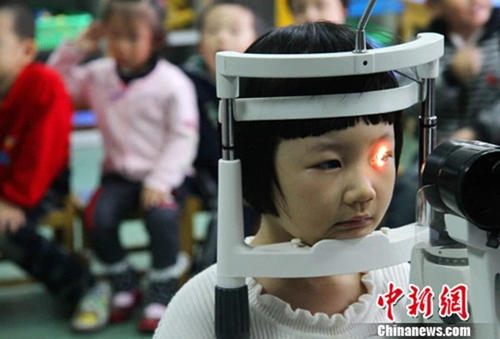


(Photo/Chinanews.com)
More than half of Chinese children and adolescents suffer from nearsightedness, according to a 2018 survey report released at a press conference held by the National Health Commission in April.
A National Vision Care Report noted that in 2012, nearly 500 million people over the age of five had a visual defect in China, among which about 450 million had myopia, the medical term for nearsightedness. Without policy intervention, by 2020, almost 700 million people are expected to suffer from myopia in China, which is twice the population of the U.S.
Four years have passed since the report was released. The Chinese government has put more effort into the prevention and control of juvenile myopia, but the rate remains high, said Li Ling, chief editor of the report.
In a long-term study starting from 2011, Dr. Wei Shifei found that the number of nearsighted primary school students increased with every grade. Almost 60 percent of students in grade six had myopia.
Professor Li, who is also a professor of the National School of Development at Peking University, told China Youth Daily that the high incidence of visual impairments would lead to a loss in GDP, and make national security recruitment difficult.
It’s estimated in the national report that the social and economic costs of visual impairments reached more than 680 billion yuan seven years ago, accounting for 1.3 percent of the national GDP that year.
Li added that people suffering badly from myopia are prone to develop eye diseases and have a higher risk of becoming blind.
Li said that the country’s public health system is behind in ocular health. Not many people in China regard myopia as a severe problem, but in fact, myopia is a disease.
Early in 2007, the Ministry of Education made a work plan to protect primary and middle school students from developing myopia.
The dominant factor for myopia lies in the burden of homework, according to a survey conducted by Zou Haidong from Shanghai General Hospital.
The myopia rate among Chinese teenagers topped all other countries, according to the China Compulsory Education Quality Oversight Report, released in 2018 by the Basic Education Quality Monitoring Center under the Ministry of Education.
Among them, over 70 percent of middle school and university students suffered from nearsightedness, while the overall rates in the U.S. and Australia stood at only 25 percent and 1.3 percent, respectively.
There has been a fierce argument between maintaining eye health and reducing the amount of homework given to students. Wang Ningli, director of the ophthalmology department of Beijing Tongren Hospital, noted that it’s the test-oriented education system that hinders eyesight.
At the annual meeting of the top legislature and advisory body, Wang proposed to include a health test in the college entrance examination in an effort to call for all-round development.
“Myopia control is a battle that requires the participation of all people,” said Wang.
 Fire brigade in Shanghai holds group wedding
Fire brigade in Shanghai holds group wedding Tourists enjoy ice sculptures in Datan Town, north China
Tourists enjoy ice sculptures in Datan Town, north China Sunset scenery of Dayan Pagoda in Xi'an
Sunset scenery of Dayan Pagoda in Xi'an Tourists have fun at scenic spot in Nanlong Town, NW China
Tourists have fun at scenic spot in Nanlong Town, NW China Harbin attracts tourists by making best use of ice in winter
Harbin attracts tourists by making best use of ice in winter In pics: FIS Alpine Ski Women's World Cup Slalom
In pics: FIS Alpine Ski Women's World Cup Slalom Black-necked cranes rest at reservoir in Lhunzhub County, Lhasa
Black-necked cranes rest at reservoir in Lhunzhub County, Lhasa China's FAST telescope will be available to foreign scientists in April
China's FAST telescope will be available to foreign scientists in April "She power" plays indispensable role in poverty alleviation
"She power" plays indispensable role in poverty alleviation Top 10 world news events of People's Daily in 2020
Top 10 world news events of People's Daily in 2020 Top 10 China news events of People's Daily in 2020
Top 10 China news events of People's Daily in 2020 Top 10 media buzzwords of 2020
Top 10 media buzzwords of 2020 Year-ender:10 major tourism stories of 2020
Year-ender:10 major tourism stories of 2020 No interference in Venezuelan issues
No interference in Venezuelan issues
 Biz prepares for trade spat
Biz prepares for trade spat
 Broadcasting Continent
Broadcasting Continent Australia wins Chinese CEOs as US loses
Australia wins Chinese CEOs as US loses